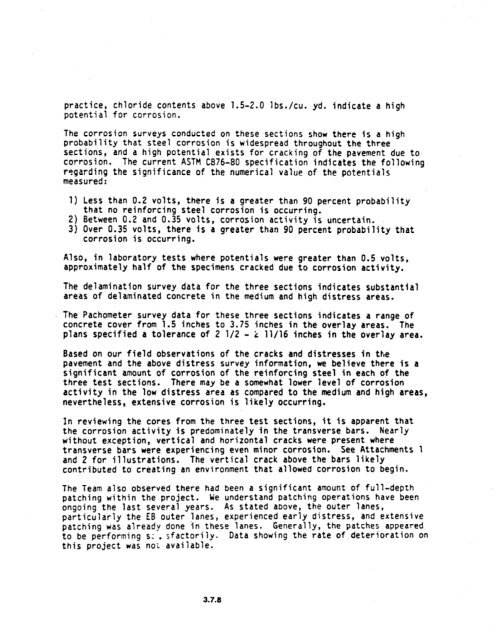chapter 3 rigid pavement - DOT On-Line Publications - Department ...
chapter 3 rigid pavement - DOT On-Line Publications - Department ...
chapter 3 rigid pavement - DOT On-Line Publications - Department ...
You also want an ePaper? Increase the reach of your titles
YUMPU automatically turns print PDFs into web optimized ePapers that Google loves.
practice, chloride contents above 1.5-2.0 lbs./cu. yd. indicate a high<br />
potential for corrosion.<br />
The corrosion surveys conducted on these sections show there is a high<br />
probability that steel corrosion is widespread throughout the three<br />
sections, and a high potential exists for cracking of the <strong>pavement</strong> due to<br />
corrosion. The current ASTM CB76-80 specification indicates the following<br />
regarding the significance of the numerical value of the potentials<br />
measured:<br />
1) Less than 0.2 volts, there is a greater than 90 percent probability<br />
that no reinforcing steel corrosion is occurring.<br />
2) Between 0.2 and 0.35 volts, corrosion activity is uncertain.<br />
3) Over 0.35 volts, there is a greater than 90 percent probability that<br />
corrosion is occurring.<br />
Also, in laboratory tests where potentials were greater than 0.5 volts,<br />
approximately half of the specimens cracked due to corrosion activity.<br />
The delamination survey data for the three sections indicates substantial<br />
areas of delaminated concrete in the medium and high distress areas.<br />
The Pachometer survey data for these three sections indicates a range of<br />
concrete cover from 1.5 inches to 3.75 inches in the overlay areas. The<br />
plans specified a tolerance of 2 l/2 - i: 11/16 inches in the overlay area.<br />
Based on our field observations of the cracks and distresses in the<br />
<strong>pavement</strong> and the above distress survey information, we believe there is a<br />
significant amount of corrosion of the reinforcing steel in each of the<br />
three test sections. There may be a somewhat lower level of corrosion<br />
activity in the low distress area as compared to the medium and high areas,<br />
nevertheless, extensive corrosion is likely occurring.<br />
In reviewing the cores from the three test sections, it is apparent that<br />
the corrosion activity is predominately in the transverse bars. Nearly<br />
without exception, vertical and horizontal cracks were present where<br />
transverse bars were experiencing even minor corrosion. See Attachments 1<br />
and 2 for illustrations. The vertical crack above the bars likely<br />
contributed to creating an environment that allowed corrosion to begin.<br />
The Team also observed there had been a significant amount of full-depth<br />
patching within the project. We understand patching operations have been<br />
ongoing the last several years. As stated above, the outer lanes,<br />
particularly the EB outer lanes, experienced early distress, and extensive<br />
patching was already done in these lanes. Generally, the patches appeared<br />
to be performing s: . sfactorily. Data showing the rate of deterioration on<br />
this project was noi available.<br />
3.7.8
















